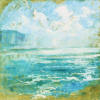1853-1902
American Tonalist Painter and founding member of the Ten American Painters
Stylistically influenced by the following painters and movements - Japanese prints, Claude Monet, George Inness, John La Farge, Julian Alden Weir and James Abbott McNeill Whistler
Education - he studied under Frank Duveneck at the Cincinnati School of Design, and later under Ludwig von Loefftz at the Royal Academy in Munich, Germany and lastly attended classes at the Academie Julian in Paris
Cause of Death - Brain aneurysm
John Henry Twachtman Quote
'I feel more and more contented with the isolation of country life. To be isolated is a fine thing and we are all then nearer to nature. 1 can see how necessary it is to live always in the country-at all seasons of the year." -- John Henry Twachtman
John Henry Biography Information
Like most creative geniuses, Twachtman was never
truly valued or recognized while he was alive. Self-assurance and
intensity characterize Twachtmans bold style. His paintings, full of
atmosphere, harmony, and lyrical color, had a contemplative quality
that was never really understood. Twachtman craved financial and
critical recognition and grew increasingly bitter by the art worlds
failure to acknowledge his greatness. In the end, like most artists, he
died embittered, surrounded by unsold masterpieces. His brilliant talent
would not be appreciated until decades after his death.
Description of the Tonalist Painting Style and Technique
Tonalism is rooted in the French Barbizon movement, which emphasized atmosphere and shadow. The unifying factor is that all the colors in the tonalist palette are nearly the same value, resulting in an understated and harmonious impression. The tonalist subject matter is never entirely apparent; their is no effort to communicate a message or narrate a story. Instead of relating a story, each sensitively chosen color, composition, and line is arranged to create an intriguing visual poem.
The interiors of tonalist paintings are generally elegant and sparsely decorated, tonally uniform, simplified and indistinct; the figures are usually presented alone in silent contemplation. Landscapes are typically luscious and luminous with evocative atmospheric effects featuring misty backgrounds illuminated by moonlight. Tonalists painters were drawn to both the natural and spiritual realms. They sought to awaken the viewers consciousness by shrouding the subject in a misty indistinct veil of emotionalism. The palette is minimal, characterized by warm hues of brown, soft greens, gauzy yellows and muted grays. Preferred themes were evocative moonlight nights and poetic, vaporous landscapes. Tonalist painters seemed to favored unconscious states and psychological experiences over reality.
Principle Painters of Tonalism Movement
Thomas Wilmer Dewing American, 1851-1938]
Robert Swain Gifford American, 1840-1905
Alexander Thomas Harrison American, 1854 -1929
Lowell Birge Harrison American, 1854-1929
George Inness American, 1825-1894
John La Farge American, 1835-1910
Arthur Frank Mathews American, 1860-1945
John Francis Murphy American, 1853-1921
Albert Pinkham Ryder American, 1847-1917
John Henry Twachtman American,1853-1902
Julian Alden Weir American,1852-1919
James Abbott McNeill Whistler American, 1843-1903
Key terms and phrase associated with the tonalist movement - obscured details, single-figure themes, the natural and spiritual domain, waking, unconscious states, sleep, dreams, death, aura, religious significance, emotionalism, emotionalists, pictorial space, compositional space, diffused light, incandescent glow, organic forms, artistic inspiration, illusionist representation, luminous, transcendentalist, glowing, metaphysical, emotional expression, poetic, evocative
© HistoryofPainters.com If you like this page and wish to share it, you are welcome to link to it, with our thanks.
If you feel you have worthwhile information you would like to contribute we would love to hear from you. We collect essential biographical information and artist quotes from folks all over the globe and appreciate your participation. When submitting please, if possible, site the source and provide English translation. Email to millardmulch@gmail.com
